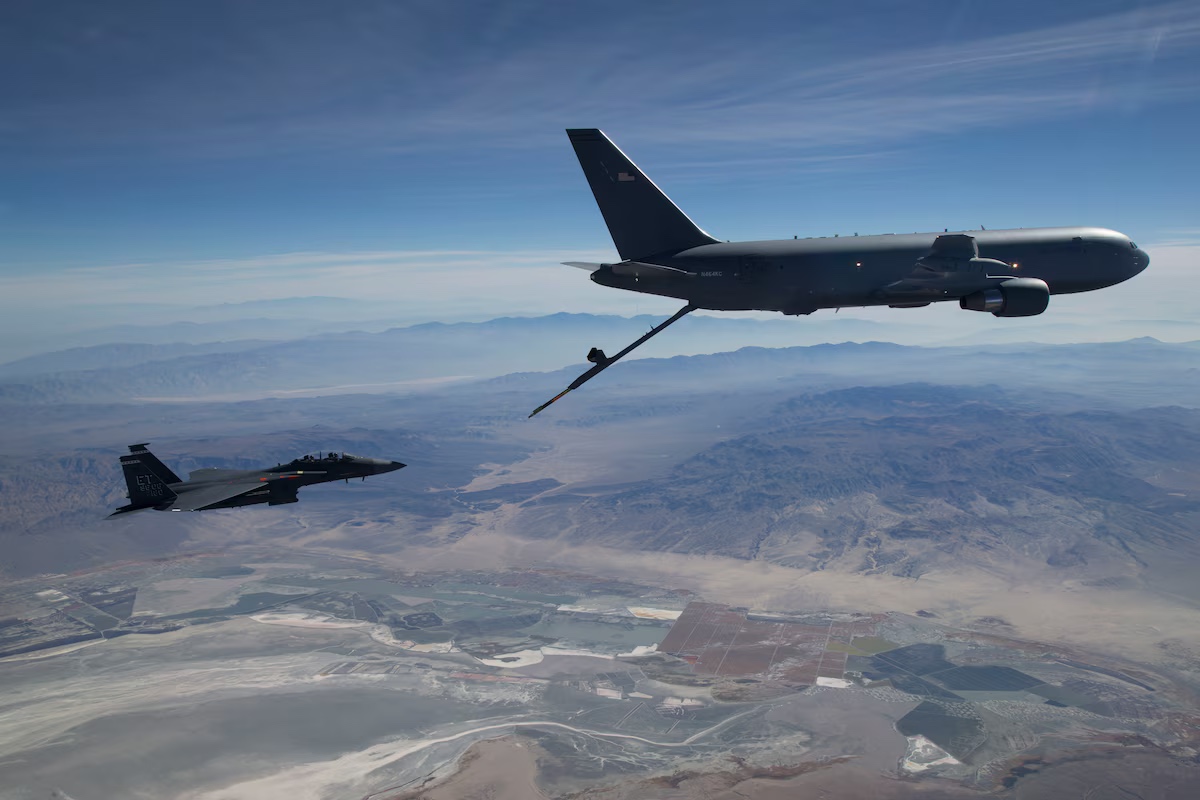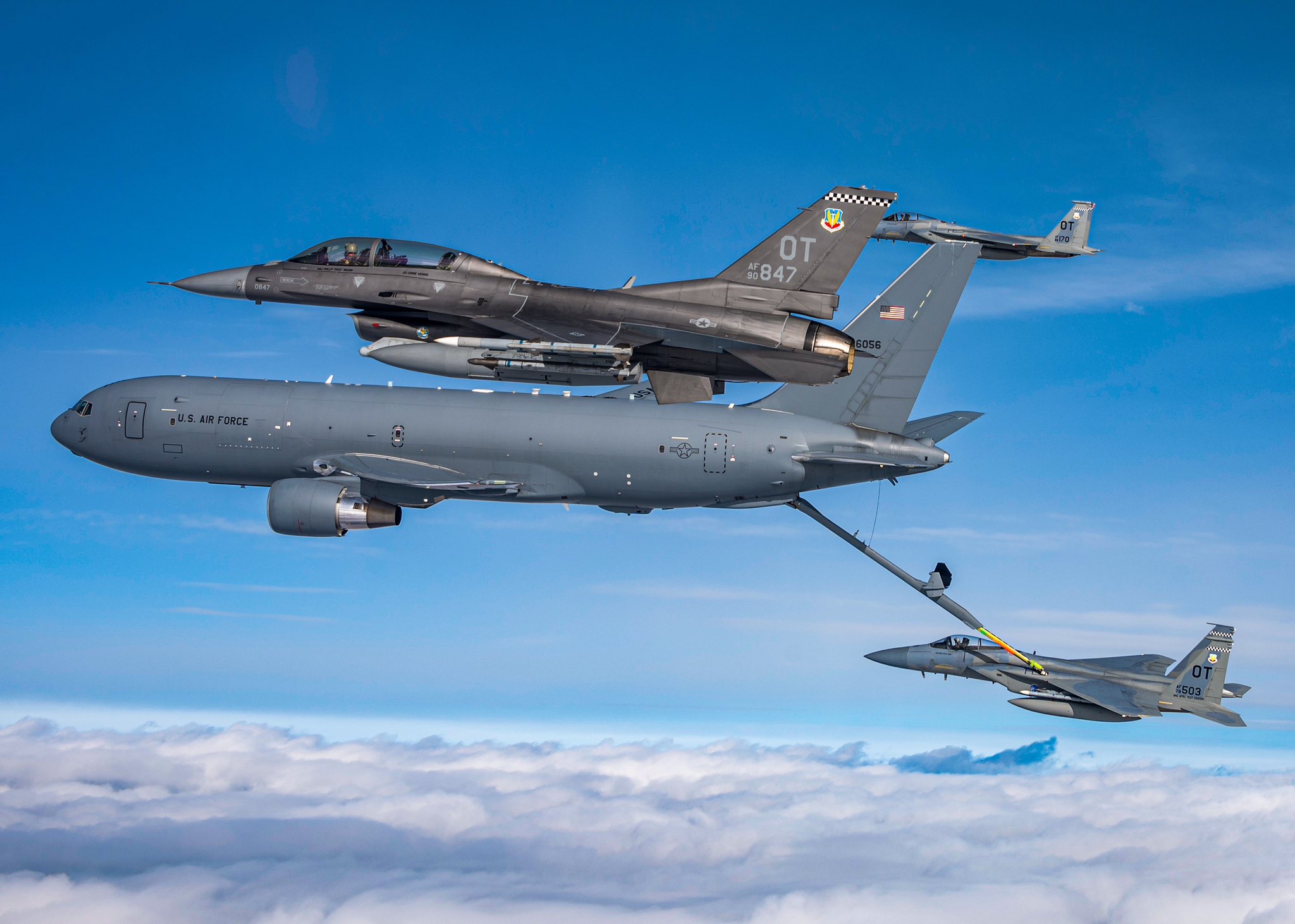The US Air Force has faced yet another mid-air incident involving a KC-46A tanker and an F-15E fighter jet. This incident was caused by a significant malfunction during a refueling operation, which led to an in-flight emergency that damaged both aircraft.
The aircraft, designated WIDE12, was refueling two F-15Es, designated NOBLE41 and NOBLE42, on August 21, 2024, while they were implementing a presidential Temporary Flight Restriction (TFR).
An unidentified issue damaged the tanker and a Strike Eagle (the F-15 designated NOBLE41) while the other F-15E aircraft (NOBLE42) was refueling.
An in-flight emergency was declared. Communication between the planes and air traffic control (ATC), subsequently published on social media, revealed that the crew of NOBLE41 radioed ATC to report that NOBLE42 was experiencing hydraulic issues and that the KC-46A (WIDE12) tanker was also reporting hydraulic issues.
One of the fighters and the tanker were forced to make emergency landings, while the F-15E had to abort its recovery attempts twice before landing at a different spot. Local news sources stated that the F-15Es involved in the incident were with the 391st Fighter Squadron at Mountain Home AFB, Idaho and that they were also purportedly carrying live weapons at the time of the incident.
The KC-46’s boom is said to have “fallen off” at one point in the communications. Following the mishap, the KC-46 made an emergency landing at Travis Air Force Base, requesting “a firefighting capability and probably a tow truck.”
Wild ATC audio, a lost tail boom and live missiles turns into quite the story 👀
NOBLE42 (F-15E Mountain Home AFB) had a incident with WIDE12 (Boeing KC-46 17-46028) yesterday near Santa Barbara, California while refueling during a CAP (Combat Air Patrol) which was enforcing a… pic.twitter.com/VkIJJZ1OIT
— Thenewarea51 (@thenewarea51) August 23, 2024
Later, a press release from the 931st Air Refueling Wing, which flew the KC-46, stated that the aircraft touched down at Travis Air Force Base in California with its boom down and that a “portion” of the boom was dropped close to the base. No one was hurt in the incident.
In the aftermath of the mishap, a few photographs were published on social media that suggested that the boom had broken into two and that the wires and pipes seemed to be exposed.
Moreover, the tanker aircraft appeared to have damaged its exhaust cone. These images could not be verified, and the USAF has not revealed the extent of the damage suffered.
The cause of the mishap remains unclear, and an investigation is being conducted to determine the cause of the accident and the specifics of the extent of damage suffered by the F-15E aircraft and KC-46 tanker.

The mishap has come as yet another setback for the KC-46A Refueler aircraft, which continues to be dogged with issues and has been in multiple accidents in the last couple of years.
The tanker aircraft has been experiencing frequent problems with the refueling system. The recent incident, for example, marks the second occurrence in as many months.
The KC-46’s Refueling Woes
On June 27, a refueling incident involving a KC-46 Pegasus tanker and a United States Air Force F-16 fighter jet took place off the coast of the Netherlands. The situation arose while a KC-46, identified by the callsign “Kanza 91,” was refueling an F-16 with the callsign “Warhawk”.
At that time, a person on the radio channel reported that an F-16, dubbed “Warhawk 3,” had “door damage” during aerial refueling and that the fighter and tanker had “a chunk taken out of his spine due to a too close breakaway incident.” The KC-46 crew described the tanker as “damaged and unable to refuel.” An investigation is still ongoing.
🇺🇸USAF Boeing KC-46A Pegasus 15-46009 as flight #KANZA91
🇺🇸USAF SP F16A as flight #WARHAWK3 (2 ship with WARHAWK2)
Issue during AAR : to close break away incident -> damage #WARHAWK3 & boom #KANZA91 #NLspot #USAF pic.twitter.com/0kTRQrHnhP
— ''The Lazy 🌴 Garden 🌴'' Eindhoven Spotter 🇳🇱 (@EHEH_Spotter) June 27, 2024
In 2022, a Pegasus was severely damaged during another aerial refueling incident in which it attempted to refuel an F-15. Soon after the crash, unverified images of the plane’s destroyed boom beneath its dented tail cone were shared on social media sites.
The USAF said the damage would be repaired at an exorbitant cost of $2.5 million. However, it noted that there were no potential systemic issues with the boom, which has been of particular concern for the USAF since at least 2018.
Another incident occurred in 2022 when a KC-46 carrying a congressional delegation had to make an emergency landing with the boom dangling below the aircraft.
KC-46 cant seem to catch a break. Today a congressional delegation was aboard this one, its refueling boom had a malfunction and couldnt retract. Jet had to make an emergency landing with the boom extended. No one hurt. pic.twitter.com/9pwUmruj39
— therealarod1984 (@therealarod1984) August 25, 2022
The Air Force and Boeing are addressing many of the Category 1 flaws in the KC-46’s refueling system. These flaws include a “stiff” boom, discovered more than five years ago. Aircraft that produce less thrust, such as the A-10, cannot generate sufficient force to keep the boom steady during refueling.
Another problem is the malfunctioning Remote Vision System (RVS), a system of cameras and monitors that the boom operator uses to link the tanker to the refueling aircraft. There are situations where the system blacks out or washes out in bright sunshine.
Furthermore, the RVS technology could hinder the boom operator’s depth perception, raising the risk of accidentally colliding with the aircraft being refueled by the KC-46.
Boeing is under contract to fix KC-46 boom stiffness issues, requiring hardware and software adjustments. The contractor is incorporating a new iteration of the Remote Vision System, in the tanker. The decision was made in response to several issues with the original RVS, which was discovered to have the potential to be physically hazardous to operate.
The Air Force authorized a revision of Boeing’s design in 2022, known as RVS 2.0, which fixes picture distortion and shadowing problems in the earlier iteration after years of delay and development. The delivery for RVS 2.0 was originally scheduled for this year. However, it has already been moved to 2026.
Boeing is also upgrading the tanker’s boom actuator. In May, the company began laboratory testing the hardware prototype it developed for this improvement.

To top it all, a new problem was identified this spring. Adding to the aircraft’s ongoing list of unfixed, high-risk design problems, the Air Force and Boeing discovered a new KC-46 defect that has reportedly been causing damage to the tanker’s air system ducts. The latest deficiency, a malfunctioning fuel pump, has been classified as a Category 1 problem due to the level of risk and operational constraints it places on the aircraft and its operator, according to reports published late last month.
Boeing responded swiftly to fix the broken ducts and is now testing a solution. Boeing and the Air Force have tackled seven Category 1 issues at various stages of completion.
Despite the persisting issues, the Air Force continues to use KC-46 and is currently exploring the possibility of using it in some high-end warfare scenarios with only a pilot and a boom operator on board.
- Contact the author at sakshi.tiwari9555 (at) gmail.com
- Follow EurAsian Times on Google News




